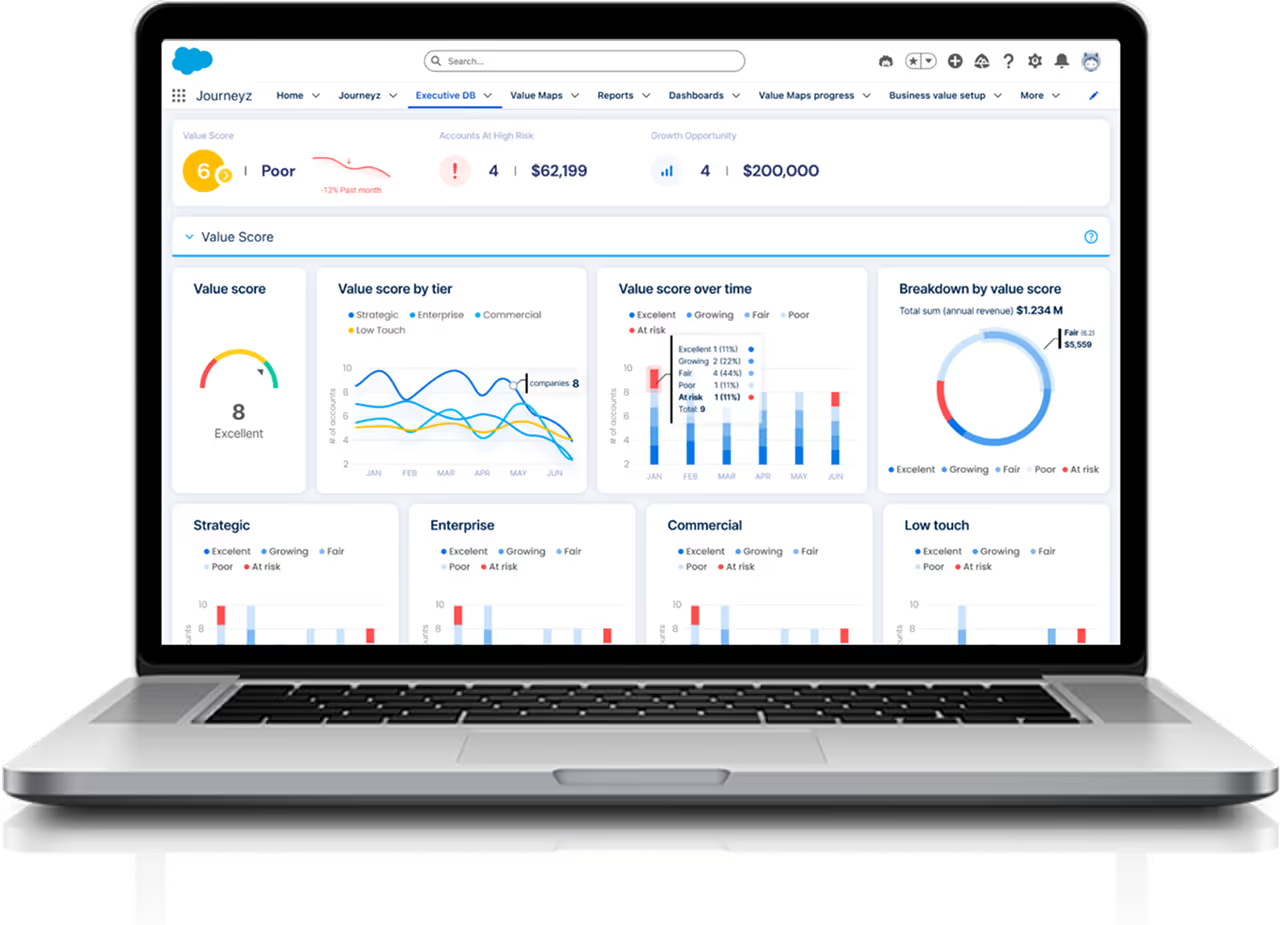Reduce B2B Churn with Dynamic, Personalized Customer Journeys
We have all experienced this before. We develop an exciting new product that solves an organizational pain point. Its intuitive user interface is designed to provide a low-touch user experience, attracting thousands of users who pay good money every month for access to the software. The users are excited to start their journey. Until they aren’t. Then, inevitably, the churn begins. And this is why CS was created.


But what if it doesn’t have to be that way? What if we had an endless amount of resources, and could maintain high user engagement by monitoring thousands of users' activity every day and manually responding based on their usage patterns? Well, we all know this is not feasible. There must be a smarter way.
Retention can be improved by personally reaching out to each user with a relevant message in the right place at the right time. This type of personalized approach would undoubtedly lead to better results.
The Problem of Churn in SaaS
I want to remind you of the magnitude of the churn that SaaS companies face today. According to a Gartner survey, 75% of businesses look for alternatives before renewing a technology contract, with only 4% not considering any other options. This may explain the record high churn rates that SaaS companies are now experiencing.
For SaaS companies, retaining customers is crucial for maintaining revenue and for protecting the investments made when acquiring and onboarding those customers. Every aspect of the business – from marketing campaigns and sales to product development and customer support – is focused on customer acquisition and retention. When these efforts fall short, the consequences can be severe. And despite significant advancements in technology, b2b customer churn continues to plague companies everywhere.
Why? We do not really treat our customers (B2B organizations) in a way that speaks their language and solves their pain. We are being too generic in the way we service our customers instead of being specific, relevant, and personalized with each of them.
The Low-Touch Engagement Challenge: Lack of Personalized Interaction
We all know that low-touch customer retention relies on minimal direct interaction. It often uses automated tools and processes to manage customer relationships and involves less frequent, more standardized communication. In low-touch environments, where there are thousands of users and hundreds of accounts per Customer Success Manager (CSM), it’s impossible to provide any type of personalization.
In recent years, several tools have developed dashboards to provide alerts to CSMs, such as if a user hasn’t logged in recently. This represents some progress and automation, but at the same time, it is a generic approach and cannot automate personalized calls to action at scale. For example, if the system detects that a specific feature has not been utilized, it might automatically suggest a training call to action. However, this approach fails to consider whether that particular feature is actually valuable or relevant to the users' needs/ account health.
As a low-touch CSM, you usually interact with customers during periods of renewals or high-risk situations. However, once the customer renews, they might be forgotten until the next renewal cycle. This practice heavily depends on the CSM's organizational skills. While a highly organized CSM might perform better than others, it's challenging to manage such a large number of customers and keep track of all communications. Additionally, not all organizations follow CRM/ CSP tools, with many CSMs using their own methods to manage customer interactions – with differing levels of success.
The High-Touch Engagement Challenge: Expensive and Timely
The situation is slightly different but still concerning when it comes to high-touch customer retention. High-touch interaction involves frequent, personalized interactions between the customer and the company. It typically includes dedicated account managers or customer success teams who provide tailored support and build close relationships with clients. For example, the CSM can become a more trusted advisor by communicating in a language deeply relevant to the customer, adding value to the product, pricing, and overall portfolio.
However, this model is very time-consuming and based on manual work to provide high-quality service and solutions. Usually, for high-touch accounts, the AM/CSM needs to interact with multiple users/ groups/ regions, making sure that each group is being helped and satisfied. That makes their job super challenging to always be on top of multiple users’ or groups' needs and requests.
Why do customer journeys need to be dynamic?
In SaaS, a lot can change over the course of a year-long contract. Champions keep on changing, market focus can shift, budgets are adjusted, and new competitors can emerge. If we look at what happened in 2022, many organizations initially adopted SaaS tools to achieve specific business goals. However, due to the economic downturn only a year later, their business objectives shifted towards efficiency and productivity. SaaS vendors that did not respond promptly to these changing needs ended up losing clients. This highlights the need for customer success organizations to be much more dynamic and adapt to evolving circumstances to ensure their service is always aligned with their customers’ goals.
Why do customer journeys need to be personalized?
Personalizing the b2b SaaS customer journey is becoming critical because it caters to the unique needs and preferences of each customer. In the competitive landscape we live in, a one-size-fits-all approach does not work anymore. What I found while consulting and advising dozens of SaaS companies, is that the key to maintaining dynamic customer journeys is through personalized calls to action.
For example, if we look at the B2C world - imagine you are a Netflix user who regularly enjoys a marathon of documentaries but then shifts to watching romantic comedies with a new partner. Netflix, by identifying this change, will begin recommending more romantic comedies and related content. Netflix realized that your choice of content has changed, and is now adopting this change to serve you better. This ability to adapt and shift enhances user engagement, satisfaction, and loyalty. The same holds true for the necessity of personalized customer journeys in the B2B world.
Traditionally, customer journey B2B SaaS strategies have focused on standardized engagement models. However, leading SaaS businesses are now adopting dynamic B2B personalization, leveraging AI and customer data to tailor interactions. This is essential because customer needs change throughout the stage of the customer lifecycle—during the onboarding process, adoption, expansion, and renewal.
By implementing customer segmentation and tracking behavioral patterns, B2B companies can deliver tailored content and recommendations at the right time based on the type of customer. They can adjust engagement strategies according to usage trends, ensuring relevance to the target audience. Additionally, by identifying early signs of disengagement, businesses can take proactive steps to prevent churn and improve customer retention.
The Bottom Line: Why Dynamic & Personalized B2B Customer Journeys Matter
The huge advancements in generative AI now make it possible for customer teams to create dynamic and personalized journeys. AI continuously analyzes customer data—whether in high-touch or low-touch scenarios—to identify current business objectives, match them with usage and adoption patterns, and provide tailored product, service, or solution-related recommendations. This approach is similar to how B2C platforms like Spotify, Amazon, and Netflix offer personalized suggestions based on user behavior.
Implementing a dynamic and personalized B2B customer solution that changes with the customer's needs is a game changer, as it ensures that user interactions and recommendations stay relevant and timely. By using genAI to adapt to dynamic customer requirements, SaaS companies can significantly enhance user satisfaction, drive higher retention rates, and foster stronger, more personalized relationships.
FAQ
How does personalization help reduce the B2B churn rate?
Personalization ensures that customers receive relevant engagement at every stage of their journey. By analyzing user behavior and tailoring interactions, SaaS businesses can proactively address pain points, increase product adoption, and reduce the B2B churn rate.
What role does AI play in preventing technology churn?
AI helps predict technology churn by identifying disengagement patterns, monitoring product usage, and recommending proactive retention strategies. AI-driven insights allow customer success teams to intervene before customers consider switching to competitors.
Ready to Start your Journeyz?
Transform your customer retention and expansion strategies with the industry’s first Customer Value Platform.

.svg)


.svg)
.webp)




